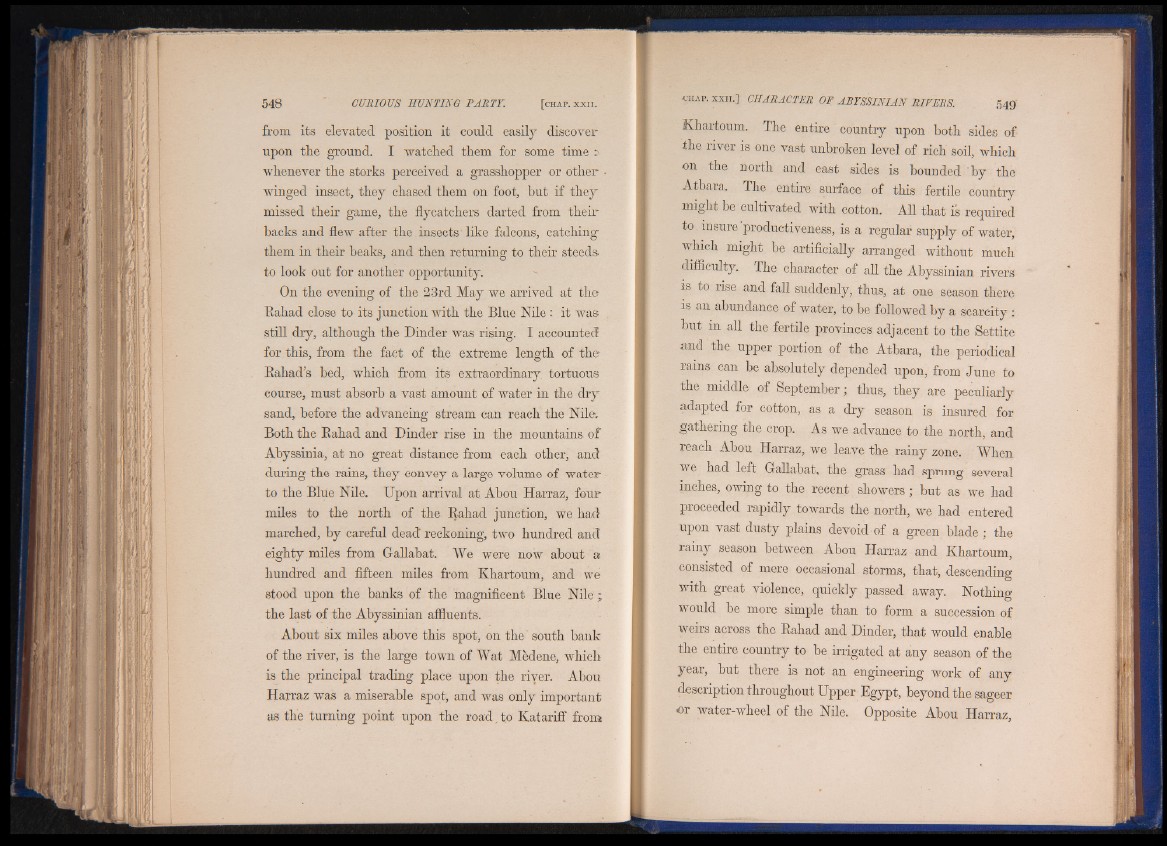
from its elevated position it could easily discover
upon the ground. I watched them for some time ^
whenever the storks perceived a grasshopper or other
winged insect, they chased them on foot, but if they
missed their game, the flycatchers darted from their
backs and flew after the insects \ like falcons, catching
them in their beaks, and then returning to their steeds-
to look out for another opportunity.
On the evening of the 23rd May we arrived at the
Bahad close to its junction with the Blue Nile : it was
still dry, although the Binder was rising. I accounted
for this, from the fact of the extreme length of the
Bahad’s bed, which from its extraordinary tortuous
course, must absorb a vast amount of water in the dry
sand, before the advancing stream can reach the Nile.
Both the Bahad and Binder rise in the mountains of
Abyssinia, at no great distance from each other, and
during the rains, they convey a large volume of water
to the Blue Nile. Upon arrival at Abou Harraz, four
miles to the north of the Bahad junction, we had
marched, by careful dead reckoning, two hundred and
eighty miles from Gallabat. We were now about a
hundred and fifteen miles from Khartoum, and we
stood upon the banks of the magnificent Blue Nile ;
the last of the Abyssinian affluents.
About six miles above this spot, on the' south bank
of the river, is the large town of Wat Medene, which
is the principal trading place upon the river. Abou
Harraz was a miserable spot, and was only important
as the turning point upon the road to Katariff from
Khartoum. The entire country upon both sides of
the river is one vast unbroken level of rich soil, which
on the north and east sides is bounded by the
Atbara. The entire surface of this fertile country
might be cultivated with cotton. All that is required
to . insure productiveness, is a regular supply of water,
which might be artificially arranged without much
difficulty. The character of all the Abyssinian rivers
is to rise and fall suddenly, thus, at one season there
is an abundance of water, to be followed by a scarcity :
but in all the fertile provinces adjacent to the Settite
and the upper portion of the Atbara, the periodical
rains can be absolutely depended upon, from June to
the middle of September; thus, they are peculiarly
adapted for cotton, as a dry season is insured for
gathering the crop. As we advance to the north, and
reach Abou Harraz, we leave the rainy zone. When
we had left Gallabat, the grass had sprung several
inches, owing to the recent showers; but as we had
proceeded rapidly towards the north, we had entered
upon vast dusty plains devoid of a green blade; the
rainy season between Abou Harraz and Khartoum,
consisted of mere occasional storms, that, descending
with great violence, quickly passed away. Nothing
would be more simple than to form a succession of
weirs across the Bahad and Binder, that would enable
the entire country to be irrigated at any season of the,
year, but there is not an engineering work of any
description throughout Upper Egypt, beyond the sageer
or water-wheel of the Nile. Opposite Abou Harraz,